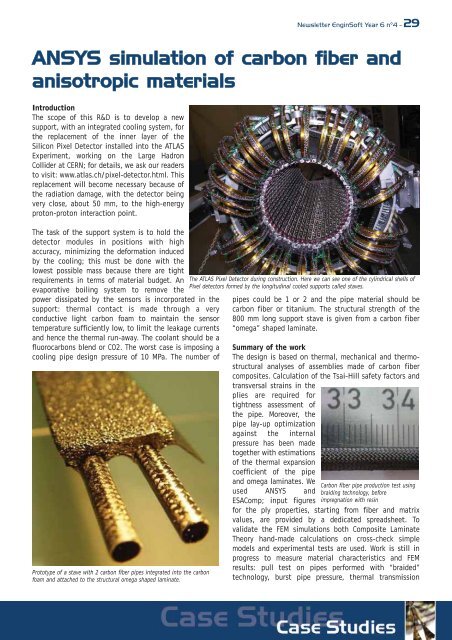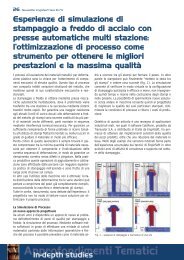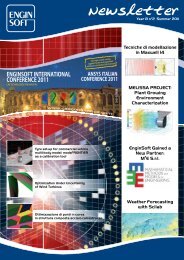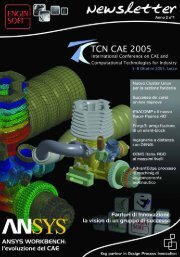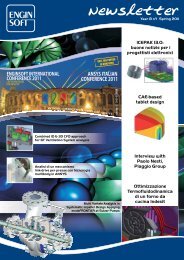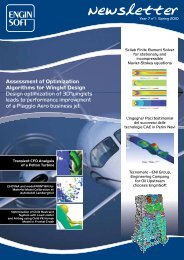software training courses 2010 corsi di addestramento ... - EnginSoft
software training courses 2010 corsi di addestramento ... - EnginSoft
software training courses 2010 corsi di addestramento ... - EnginSoft
Create successful ePaper yourself
Turn your PDF publications into a flip-book with our unique Google optimized e-Paper software.
Newsletter <strong>EnginSoft</strong> Year 6 n°4 - 29<br />
ANSYS simulation of carbon fiber and<br />
anisotropic materials<br />
Introduction<br />
The scope of this R&D is to develop a new<br />
support, with an integrated cooling system, for<br />
the replacement of the inner layer of the<br />
Silicon Pixel Detector installed into the ATLAS<br />
Experiment, working on the Large Hadron<br />
Collider at CERN; for details, we ask our readers<br />
to visit: www.atlas.ch/pixel-detector.html. This<br />
replacement will become necessary because of<br />
the ra<strong>di</strong>ation damage, with the detector being<br />
very close, about 50 mm, to the high-energy<br />
proton-proton interaction point.<br />
The task of the support system is to hold the<br />
detector modules in positions with high<br />
accuracy, minimizing the deformation induced<br />
by the cooling; this must be done with the<br />
lowest possible mass because there are tight<br />
requirements in terms of material budget. An<br />
evaporative boiling system to remove the<br />
power <strong>di</strong>ssipated by the sensors is incorporated in the<br />
support: thermal contact is made through a very<br />
conductive light carbon foam to maintain the sensor<br />
temperature sufficiently low, to limit the leakage currents<br />
and hence the thermal run-away. The coolant should be a<br />
fluorocarbons blend or CO2. The worst case is imposing a<br />
cooling pipe design pressure of 10 MPa. The number of<br />
Prototype of a stave with 2 carbon fiber pipes integrated into the carbon<br />
foam and attached to the structural omega shaped laminate.<br />
The ATLAS Pixel Detector during construction. Here we can see one of the cylindrical shells of<br />
Pixel detectors formed by the longitu<strong>di</strong>nal cooled supports called staves.<br />
pipes could be 1 or 2 and the pipe material should be<br />
carbon fiber or titanium. The structural strength of the<br />
800 mm long support stave is given from a carbon fiber<br />
“omega” shaped laminate.<br />
Summary of the work<br />
The design is based on thermal, mechanical and thermostructural<br />
analyses of assemblies made of carbon fiber<br />
composites. Calculation of the Tsai-Hill safety factors and<br />
transversal strains in the<br />
plies are required for<br />
tightness assessment of<br />
the pipe. Moreover, the<br />
pipe lay-up optimization<br />
against the internal<br />
pressure has been made<br />
together with estimations<br />
of the thermal expansion<br />
coefficient of the pipe<br />
and omega laminates. We<br />
used ANSYS and<br />
ESAComp; input figures<br />
Carbon fiber pipe production test using<br />
brai<strong>di</strong>ng technology, before<br />
impregnation with resin<br />
for the ply properties, starting from fiber and matrix<br />
values, are provided by a de<strong>di</strong>cated spreadsheet. To<br />
validate the FEM simulations both Composite Laminate<br />
Theory hand-made calculations on cross-check simple<br />
models and experimental tests are used. Work is still in<br />
progress to measure material characteristics and FEM<br />
results: pull test on pipes performed with “braided”<br />
technology, burst pipe pressure, thermal transmission


